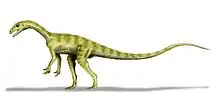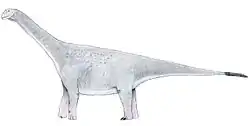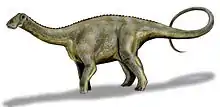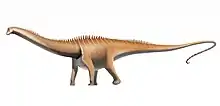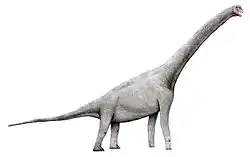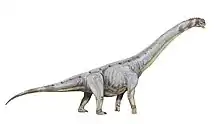Hudiesaurus
Hudiesaurus (meaning "butterfly lizard") is a herbivorous sauropod genus of dinosaur from China. The fossil remains of Hudiesaurus were in 1993 found by a Chinese-Japanese expedition near Qiketai in Shanshan, Xinjiang province. The type (and only named) species, Hudiesaurus sinojapanorum, was named and described by Dong Zhiming in 1997. The generic name is derived from Mandarin hudie, "butterfly" and refers to a flat butterfly-shaped process on the front base of the vertebral spine. The specific name refers to the members of the expedition but can also be read as "central part" in Chinese, a pun on the Japanese Chunichi Shinbun (again "central part") press group, which financed the research.[1]
| Hudiesaurus Temporal range: Late Jurassic | |
|---|---|
| Scientific classification | |
| Kingdom: | Animalia |
| Phylum: | Chordata |
| Clade: | Dinosauria |
| Clade: | Saurischia |
| Suborder: | †Sauropodomorpha |
| Clade: | †Sauropoda |
| Clade: | †Eusauropoda |
| Family: | †Mamenchisauridae |
| Genus: | †Hudiesaurus Dong, 1997 |
| Species: | †H. sinojapanorum |
| Binomial name | |
| †Hudiesaurus sinojapanorum Dong, 1997 | |
Hudiesaurus is known from only two incomplete specimens, uncovered within sediments in the Turpan Basin equivalent to the Kalazha Formation of the Junggar Basin, which perhaps dates to the late Jurassic Period. The type specimen (IVPP V 11120) is represented only by a very large anterior dorsal vertebra. Another partial skeleton from an apparently smaller individual found about a kilometre away from the holotype, consisting of a nearly complete right front leg and teeth, specimen IVPP P. 11121, has by Dong been referred to this species.[1] Paul Upchurch in 2004 rejected the identity because of a lack of overlapping material.[2]
Although the specimens are fragmentary, Hudiesaurus is believed to have been very large, even for sauropods, given the considerable length of the vertebral centrum of fifty-five centimetres. Its body length is estimated at 20–30 m (66–98 ft).[3][1] In 2016, Gregory S. Paul estimated its length at 25 meters (82 ft) and its weight at 25 tonnes (27.5 short tons).[4] In 2020, Molina-Perez and Larramendi gave a larger estimation of 30.5 meters (100 ft) and 44 tonnes (48.5 short tons), suggesting that the vertebra may be a cervical instead of a thoracic, in which case the animal would be at 32 meters (105 ft) and 55 tonnes (60.6 short tons).[5]
Dong thought Hudiesaurus may have been related to Mamenchisaurus and accordingly placed it in the Mamenchisauridae. Upchurch in 2004 limited the precision to a more general Eusauropoda.[2]
References
- Dong, Z. (1997). "A gigantic sauropod (Hudiesaurus sinojapanorum gen. et sp. nov.) from the Turpan Basin, China." Pp. 102-110 in Dong, Z. (ed.), Sino-Japanese Silk Road Dinosaur Expedition. China Ocean Press, Beijing.
- Upchurch, P.; Barrett, P.M.; Dodson, P.; 2004 "Sauropoda". In: Weishampel, D.B. and Dodson, P. and Osmolska, H., (eds.) The Dinosauria. p 259 - 322. University of California Press: Berkeley and Los Angeles
- Holtz, Thomas R. Jr. (2011) Dinosaurs: The Most Complete, Up-to-Date Encyclopedia for Dinosaur Lovers of All Ages, Winter 2010 Appendix.
- Paul, Gregory S. (2016). The Princeton Field Guide to Dinosaurs 2nd Edition. New Jersey: Princeton University Press. p. 207.
- Molina-Perez & Larramendi (2020). Dinosaur Facts and Figures: The Sauropods and Other Sauropodomorphs. New Jersey: Princeton University Press. p. 252.
